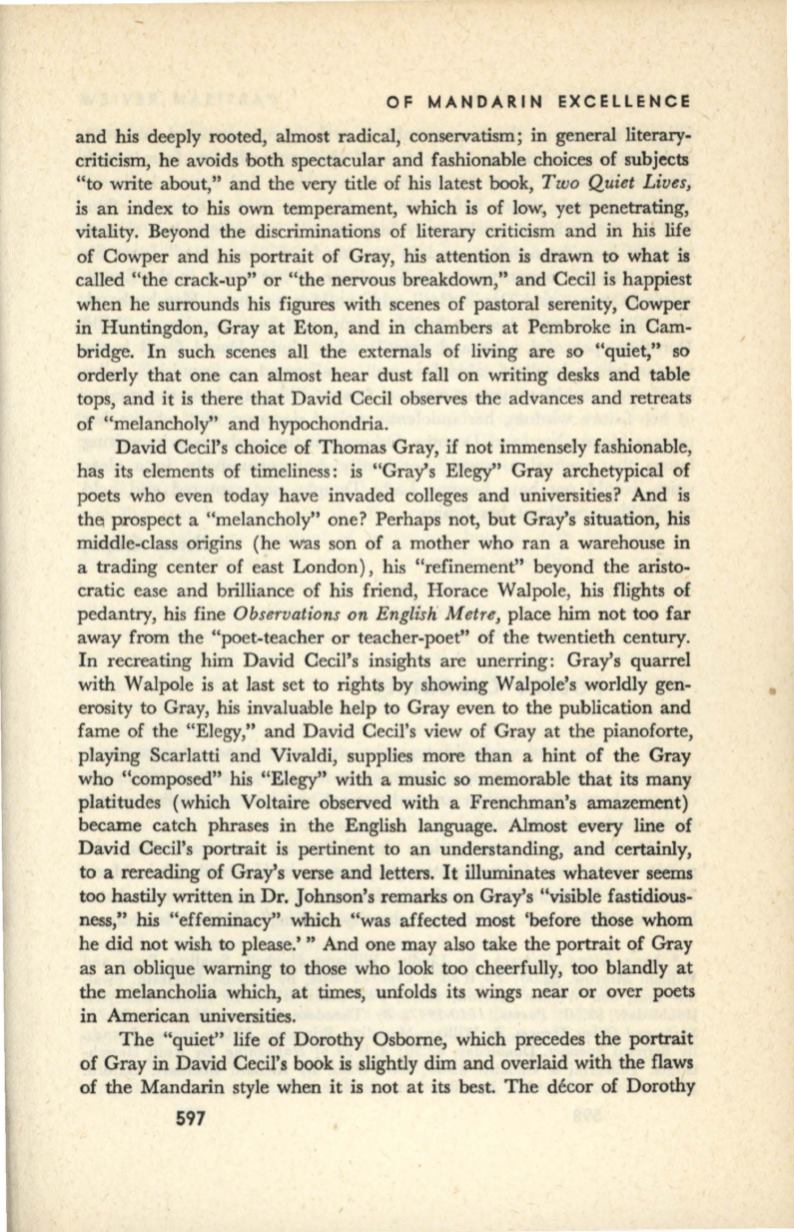
OF MANDARIN EXCELLENCE
and his deeply rooted, almost radical, conseiVatism; in general literary–
criticism, he avoids both spectacular and fashionable choices of subjects
"to write about," and the very title of his latest book,
Two Quiet Lives,
is an index to his own temperament, which is of low:, yet penetrating,
vitality. Beyond the discriminations of literary criticism and in his life
of Cowper and his portrait of Gray, his attention is drawn to what
is
called "the crack-up" or "the neiVous breakdown," and Cecil is happiest
when he surrounds his figures with scenes of pastoral serenity, Cowper
in Huntingdon, Gray at Eton, and in chambers at Pembroke in Cam–
bridge. In such scenes all the externals of living are so "quiet," so
orderly that one can almost hear dust fall on writing desks and table
tops, and it is there that David Cecil observes the advances and retreats
of "melancholy" and hypochondria.
David Cecil's choice of Thomas Gray,
if
not immensely fashionable,
has its elements of timeliness: is "Gray's Elegy" Gray archetypical of
poets who even today have invaded colleges and universities? And is
thCi prospect a "melancholy" one? Perhaps not, but Gray's situation, his
middle-class origins (he w:as son of a mother who ran a warehouse in
a trading center of east London), his "refinement" beyond the aristo–
cratic ease and brilliance of his friend, Horace Walpole, his flights of
pedantry, his fine
Observations on English' Metre,
place
him
not too far
away from the "poet-teacher or teacher-poet" of the twentieth century.
In recreating him David Cecil's insights are unerring: Gray's quarrel
with Walpole is at last set to rights by showing Walpole's worldly gen–
erosity to Gray, his invaluable help to Gray even to the publication and
fame of the "Elegy," and David Cecil's view of Gray at the pianoforte,
playing Scarlatti and Vivaldi, supplies more than a hint of the Gray
who "composed" his "Elegy" with a music so memorable that its many
platitudes (which Voltaire obseiVed with a Frenchman's amazement)
became catch phrases in the English language. Almost every line of
David Cecil's portrait is pertinent to an understanding, and certainly,
to a rereading of Gray's verse and letters. It illuminates whatever seems
too hastily written in Dr. Johnson's remarks on Gray's "visible fastidious–
ness,"
his
"effeminacy'' which "was affected most 'before those whom
he did not wish to please.' " And one may also take the portrait of Gray
as an oblique warning to those who look too cheerfully, too blandly at
the melancholia which, at times, unfolds its wings near or over poets
in American universities.
The "quiet" life of Dorothy Osborne, which precedes the portrait
of Gray in David Cecil's book is slightly dim and overlaid with the flaws
of the Mandarin style when it
is
not at its best. The decor of Dorothy
597
•


